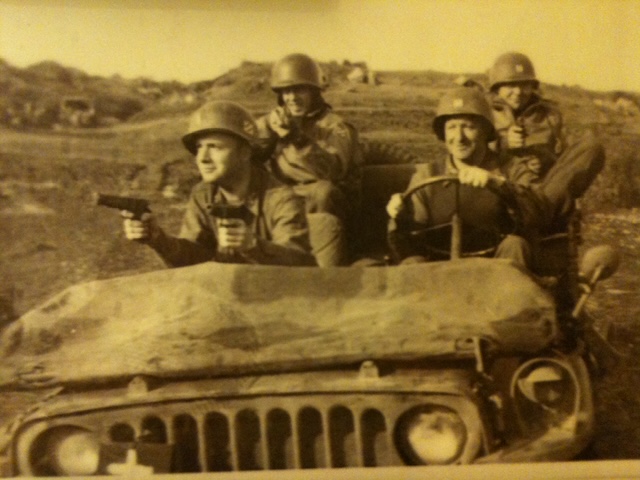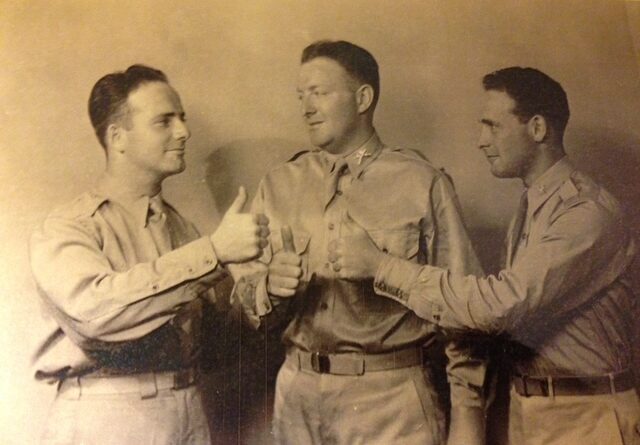Brothers in Arms: Baltimore’s Ace, Larry, and Rock Rosner
Three brothers with remarkable WWII journeys are honored with bricks on the campus of the National WWII Museum.
NEW ORLEANS — In 1942, the three “Rosner Roughnecks” — Ace, Larry, and Rock — left their family home in Baltimore, Maryland, to fight in the war in Europe. Early that year, the three brothers met up at Officer Candidate School at Fort Benning, Georgia. It would be four years before they were together again. All three came home, though Ace did so without most of his right arm.
Ace and Larry joined the infantry. Baby brother Norman, known as “Rock” since his competitive boxing days at the University of Alabama, joined the Eighth Air Force.
Rock flew 62 combat missions as lead bombardier/navigator on B-26 Martin Marauders with the 323rd Bomb Group’s 454th Bomb Squadron based in England. They bombed V–1 and V-2 rocket sites along the European coast and flew pre-D-Day bombing runs in France. On one mission, Rock and his crew were joined by a young reporter named Walter Cronkite.

Ace (derived from his first initials, A.C.) started out as the photographer for the 29th Infantry Division. Before his enlistment, Ace had worked as a stringer for the Baltimore News-Post. After becoming an officer, he joined the 3rd Infantry Division, fighting in four invasions: North Africa, Sicily, Salerno, and Anzio. He was awarded four Purple Hearts and four Bronze Stars for valor. “It was just a two-year camping trip,” Ace used to say, “except people were shooting at me.
Larry, the eldest brother, spent the early part of his service at Fort Leonard Wood in Missouri. When Ace was at Anzio, a fellow soldier from Baltimore said, “Hey, I saw your brother Larry at the Anzio harbor leading a company of DUKWs.” Ace said, “That’s not possible. Larry is stationed in Missouri.” Sure enough, the two found each other at Anzio. Larry would visit Ace at his front-line foxhole where together they wrote letters to their parents in Baltimore.
It was at Anzio, a half-hour south of Rome, on June 1, 1944, that Ace’s right arm was shattered by a German “88” shell, which killed everyone around him and nearly took his life as well. He walked to an aid station but had lost so much blood that two chaplains started administering his last rites. One chaplain asked, “Is there anything we can do for you?” Ace responded, “Yeah, you can go get my brother Larry. He’s 20 minutes down the road.” The chaplains said, “We can’t do that.” A doctor gave Ace ether to knock him out before amputating his right arm above the elbow. The next day, Ace woke up to find Larry sitting beside him and giving him blood transfusions. “One of those chaplains got in a jeep and found Larry,” Ace used to say when telling the story.

In 2011, Larry and Ace died within two months of each other at the ages of 96 and 94, respectively. They are buried side by side at Arlington National Cemetery in Washington, D.C. Rock, who died a year earlier at the age of 90, is buried one long row away.
Ace, Larry, and Rock are honored with commemorative bricks in the atrium of The National WWII Museum’s Campaigns of Courage pavilion. It’s the one place where they are all together.
(This piece first appeared in the quarterly newsletter of The National WWII Museum: Vol. 53, No. 4 WINTER 2025, and is posted here with permission of the author.)

Jaime Steve is a resident of Alexandria, VA and Middleburg, VA. He was lucky enough to know all three of the Rosner brothers and was best friends with Ace Rosner for nearly twenty years.

